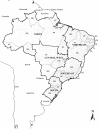Mortality and case fatality due to visceral leishmaniasis in Brazil: a nationwide analysis of epidemiology, trends and spatial patterns
- PMID: 24699517
- PMCID: PMC3974809
- DOI: 10.1371/journal.pone.0093770
Mortality and case fatality due to visceral leishmaniasis in Brazil: a nationwide analysis of epidemiology, trends and spatial patterns
Abstract
Background: Visceral leishmaniasis (VL) is a significant public health problem in Brazil and several regions of the world. This study investigated the magnitude, temporal trends and spatial distribution of mortality related to VL in Brazil.
Methods: We performed a study based on secondary data obtained from the Brazilian Mortality Information System. We included all deaths in Brazil from 2000 to 2011, in which VL was recorded as cause of death. We present epidemiological characteristics, trend analysis of mortality and case fatality rates by joinpoint regression models, and spatial analysis using municipalities as geographical units of analysis.
Results: In the study period, 12,491,280 deaths were recorded in Brazil. VL was mentioned in 3,322 (0.03%) deaths. Average annual age-adjusted mortality rate was 0.15 deaths per 100,000 inhabitants and case fatality rate 8.1%. Highest mortality rates were observed in males (0.19 deaths/100,000 inhabitants), <1 year-olds (1.03 deaths/100,000 inhabitants) and residents in Northeast region (0.30 deaths/100,000 inhabitants). Highest case fatality rates were observed in males (8.8%), ≥ 70 year-olds (43.8%) and residents in South region (17.7%). Mortality and case fatality rates showed a significant increase in Brazil over the period, with different patterns between regions: increasing mortality rates in the North (Annual Percent Change--APC: 9.4%; 95% confidence interval--CI: 5.3 to 13.6), and Southeast (APC: 8.1%; 95% CI: 2.6 to 13.9); and increasing case fatality rates in the Northeast (APC: 4.0%; 95% CI: 0.8 to 7.4). Spatial analysis identified a major cluster of high mortality encompassing a wide geographic range in North and Northeast Brazil.
Conclusions: Despite ongoing control strategies, mortality related to VL in Brazil is increasing. Mortality and case fatality vary considerably between regions, and surveillance and control measures should be prioritized in high-risk clusters. Early diagnosis and treatment are fundamental strategies for reducing case fatality of VL in Brazil.
Conflict of interest statement
Figures






References
-
- Word Health Organization (2010) Control of the leishmaniases: report of a meeting of the WHO expert committee on the control of leishmaniases. Geneva: World Health Organization. Available: http://whqlibdoc.who.int/trs/WHO_TRS_949_eng.pdf. Accessed 2013 April 30.
-
- Desjeux P (2004) Leishmaniasis: Current situation and new perspectives. Comp Immunol Microbiol Infect Dis 27: 305–318. - PubMed
-
- Secretaria de Vigilância em Saúde (2006) Manual de vigilância e controle da leishmaniose visceral. Brasília: Ministério da Saúde. Available: http://portal.saude.gov.br/portal/arquivos/pdf/manual_leish_visceral2006.... Accessed 2013 April 30.
MeSH terms
LinkOut - more resources
Full Text Sources
Other Literature Sources

